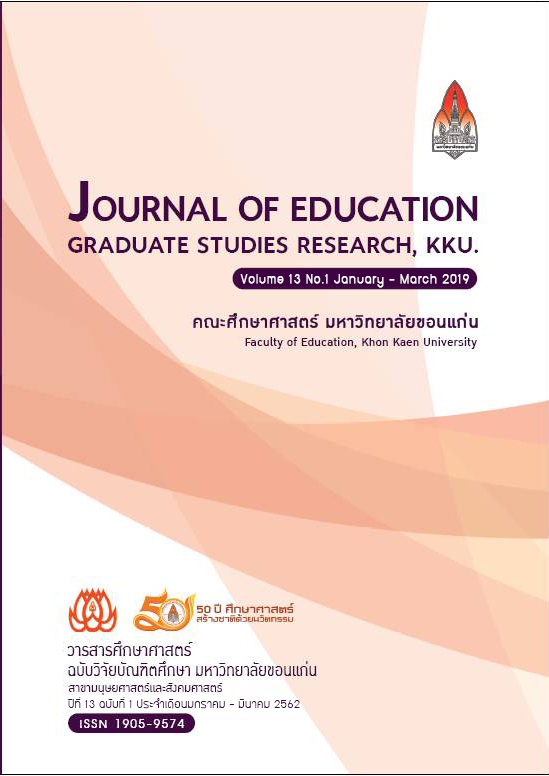ผลการจัดการเรียนรู้วิชาศิลปะ เรื่อง ประติมากรรมจากวัสดุธรรมชาติ ด้วยการจัดการเรียนรู้ แบบใช้โครงงานเป็นฐาน ของนักเรียนชั้นมัธยมศึกษาปีที่ 3
Main Article Content
บทคัดย่อ
การศึกษาวิจัยครั้งนี้มีวัตถุประสงค์ 1) เพื่อศึกษาผลการจัดการเรียนรู้วิชาศิลปะ เรื่อง ประติมากรรมจากวัสดุธรรมชาติ ด้วยการจัดการเรียนรู้แบบใช้โครงงานเป็นฐาน โดยให้นักเรียนมีคะแนนเฉลี่ยร้อยละ 70 ขึ้นไป และมีจำนวนนักเรียนที่ผ่านเกณฑ์ไม่ต่ำกว่าร้อยละ 70 2) เพื่อศึกษาความพึงพอใจของนักเรียนต่อการจัดการเรียนรู้วิชาศิลปะ เรื่อง ประติมากรรมจากวัสดุธรรมชาติ ด้วยการจัดการเรียนรู้แบบใช้โครงงานเป็นฐานของนักเรียนชั้นมัธยมศึกษาปีที่ 3 ที่กำลังศึกษาอยู่ในภาคเรียนที่ 2 ปีการศึกษา 2560 โรงเรียนบ้านหนองแปน อำเภอมัญจาคีรี จังหวัดขอนแก่น จำนวนนักเรียน 19 คน ใช้รูปแบบการวิจัยเชิงทดลองขั้นต้น (One-Shot Case Study) เครื่องมือที่ใช้ในการศึกษา ได้แก่ แผนการจัดการเรียนรู้แบบใช้โครงงานเป็นฐาน จำนวน 9 แผน แบบทดสอบวัดผลสัมฤทธิ์ทางการเรียน แบบประเมินโครงงานของนักเรียน และ แบบประเมินความพึงพอใจของนักเรียนต่อการจัดกิจกรรมการเรียนรู้ วิเคราะห์ข้อมูลโดยใช้ร้อยละ ค่าเฉลี่ย และส่วนเบี่ยงเบนมาตรฐาน
ผลการศึกษาพบว่า
- ผลการจัดการเรียนรู้วิชาศิลปะ เรื่อง ประติมากรรมจากวัสดุธรรมชาติ ด้วยการจัดการเรียนรู้แบบใช้โครงงานเป็นฐาน ของนักเรียนชั้นมัธยมศึกษาปีที่ 3 จากคะแนนเต็ม 100 คะแนน นักเรียนมีค่าเฉลี่ย 26.77 คิดเป็นร้อยละ 80.32 ของนักเรียนทั้งหมด มีนักเรียนผ่านเกณฑ์ 19 คน คิดเป็นร้อยละ 100 ซึ่งผ่านเกณฑ์ที่กำหนดไว้
- ผลการศึกษาความพึงพอใจของนักเรียนที่มีต่อการเรียนจัดการเรียนรู้ วิชาศิลปะ เรื่อง ประติมากรรมจากวัสดุธรรมชาติ ด้วยการจัดการเรียนรู้แบบใช้โครงงานเป็นฐาน ของนักเรียนชั้นมัธยมศึกษาปีที่ 3 มีค่าเฉลี่ยอยู่ในระดับ 4.79 มีความพอใจอยู่ในระดับคุณภาพมากที่สุด
Article Details
เอกสารอ้างอิง
กมลวรรณ มั่นสติ. (2550). การพัฒนาแผนการจัดการเรียนรู้แบบโครงงาน เรื่อง การออกแบบผลิตภัณฑ์จากมะพร้าว กลุ่มสาระการเรียนรู้การงานอาชีพและเทคโนโลยี ชั้นมัธยมศึกษาปีที่ 3. วิทยานิพนธ์ปริญญาการศึกษามหาบัณฑิต สาขาวิชาหลักสูตรและการสอน บัณฑิตวิทยาลัย มหาวิทยาลัยมหาสารคาม.
กระทรวงศึกษาธิการ. (2551). หลักสูตรแกนกลางการศึกษาขั้นพื้นฐาน พุทธศักราช 2551. กรุงเทพฯ: ครุสภาลาดพร้าว.
ทิฆัมพร ศรีวัฒนพงศ์. (2550). การพัฒนาแผนการจัดการเรียนรู้โดยโครงงานเรื่องการประดิษฐ์ของชำร่วยกลุ่มสาระการเรียนรู้การงานอาชีพและเทคโนโลยี ชั้นมัธยมศึกษาปีที่ 1. วิทยานิพนธ์ศึกษาศาสตรมหาบัณฑิต สาขาวิชาหลักสูตรและการสอน บัณฑิตวิทยาลัย มหาวิทยาลัยมหาสารคาม.
ธีรารัตน์ พรหมดวงดี. (2554). การจัดกิจกรรมการเรียนรู้สาระทัศนศิลป์ เรื่อง วรรณกรรมสินไซโดยใช้รูปแบบการสอนแบบโครงงาน สำหรับ นักเรียนชั้นมัธยมศึกษาปีที่ 1. วารสารศึกษาศาสตร์ ฉบับวิจัยบัณฑิตศึกษา มหาวิทยาลัยขอนแก่น, 5(1), 200-208.
นภา นรานอก. (2554). ผลการจัดการเรียนการเรียนรู้แบบโครงงาน เรื่อง การประดิษฐ์ของใช้จากวัสดุในท้องถิ่น สำหรับนักเรียนชั้นมัธยมศึกษาปีที่ 2. การศึกษาอิสระปริญญาศึกษาศาสตร์มหาบัณฑิต สาขาวิชาหลักสูตรและการสอนบัณฑิตวิทยาลัย มหาวิทยาลัยขอนแก่น.
ปรียา บุญญสิริ และคณะ. (2553). กลวิธีการจัดการเรียนรู้ โดยการทำโครงงานระดับประถมศึกษา. กรุงเทพฯ: พัฒนาคุณภาพวิชาการ.
วิจารณ์ พานิช. (2555). วิถีสร้างการเรียนรู้เพื่อศิษย์ในศตวรรษที่ 21. กรุงเทพฯ: มูลนิธิสดศรีสฤษดิ์วงศ์.
Bender, W. N. (2012). Project-Based Learning: Differentiating Instruction for the 21st Century. California: CORWIN A SAGE Company.
Efstratia, D. (2014). Experiential education through project-based learning. Procedia-Social and Behavioral Sciences, 152, 1256-1260.

